9 Years of Shadows is a non-linear platformer about a woman exploring a towering castle hoping to end a curse that plagues her world. It’s been nine years since the curse appeared, draining all color from the lands and peoples it affects. Some of those it touches are smothered by shadows. Others persist in the grey wasteland, helpless to do anything but watch as those around them slowly die. One survivor is Europa, a woman who witnessed her parents’ death by the curse and pursues rumors about its origins to a castle named Talos. Once inside, she teams up with a haunted teddy bear named Apino whose presence restores the world’s color. Utilizing the unique properties of four magical suits of armor to explore the castle, Europa hopes to discover the source of the curse and dispel it forever.
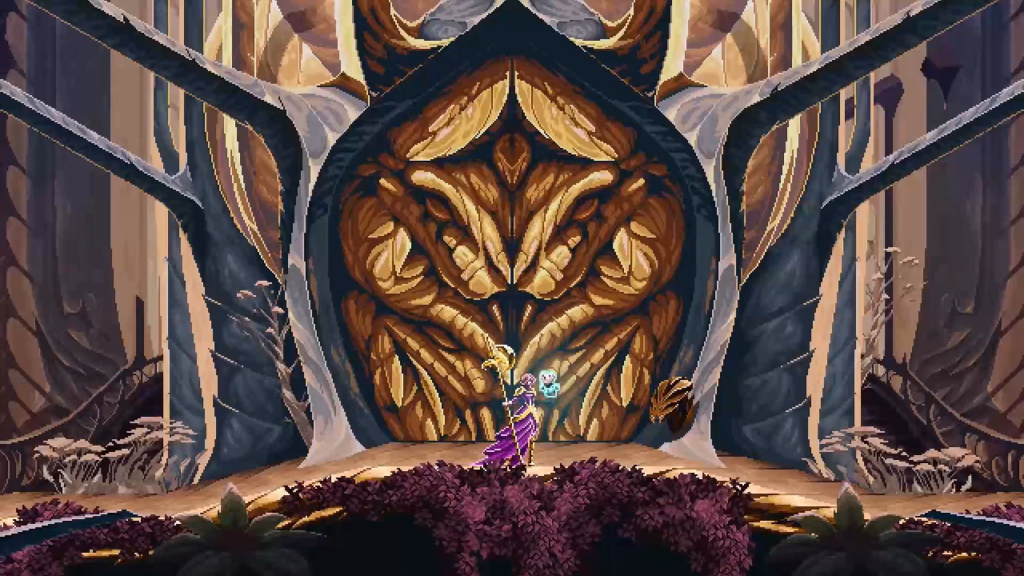
It takes a while for 9 Years of Shadows to reveal what makes it unique among other non-linear platformers. I guide Europa and Apino through Talos’ labyrinthian structure, jumping up and down to different passages and fighting off the castle’s hostile occupants with Europa’s halberd. By following the most direct path, Europa accumulates new abilities like a double jump that lets her access passages that were previously beyond her reach. If I take the time to point her to each area’s remote dead ends and distant corners, she discovers collectibles she can trade for upgrades to her combat equipment and life total at a hub filled with friendly NPCs.
It doesn’t take me long to notice that Talos isn’t a very interesting place to explore. Each area is connected by only a few passages, making them feel singular and isolated instead of part of a cohesive whole. In some ways, this works in the castle’s favor. I can’t quite grasp what this structure is meant to be, instilling the time I spend there with chaos and mystery. This helps me accept that it can support an orphanage and multiple music venues beside its monster-infested opulence. But this chaos also makes it unmemorable. I spend more than ten hours exploring Talos with Europa and Apino and recall few details about the areas we witness.
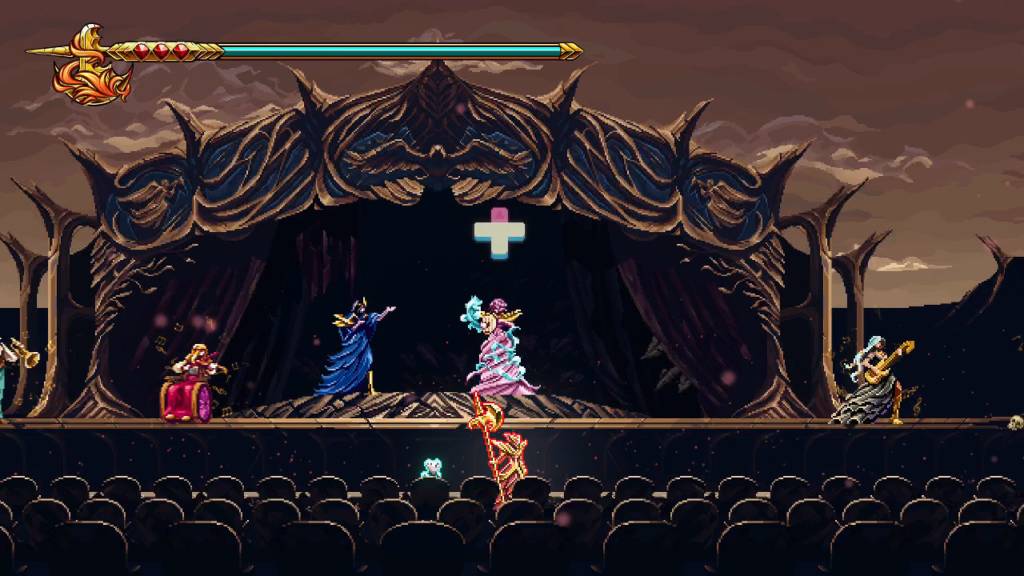
Talos’ shape affects its design as well. In order to fit into the cylindrical tower, the castle’s total layout is built with rigorous symmetry. This quashes the traditional exploratory focus of a non-linear platformer. While I still need to help Europa chart the exact layout of rooms, I always know in what direction the passages between areas lie. They will be found at a mirrored point from a passage on the map’s opposite end. There is no sense of discovery to exploring Talos, and thus no sense of joy.
Talos swarms with monsters Europa must dispatch while she explores. Huge knights wielding swords twice her size block entire hallways. Lizard-like creatures take pot shots at her with their arm cannons as she rushes by; some of them even fly. Slow-moving bulls heave their ponderous bodies towards the heroine and unleash elementally-charged breath attacks when she draws near. Every non-linear platformer owes its roots to both Metroid and the Koji Igarashi-developed Castlevania titles, and the monster designs in 9 Years of Shadows feels especially beholden to these foundations.
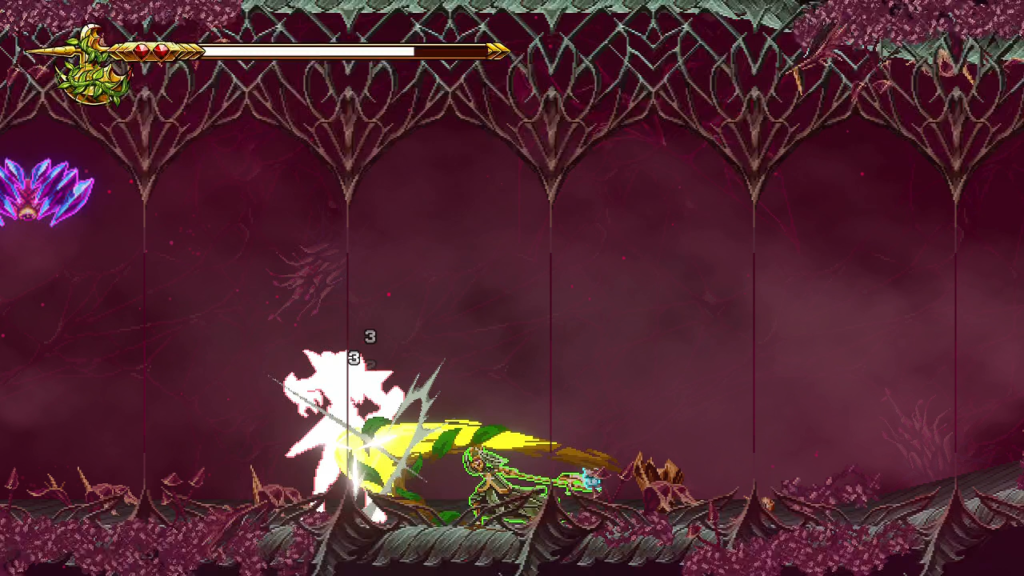
Combat is primarily melee-driven. By tapping the fast attack button multiple times in succession, Europa swings her halberd in a quick combo. The combo can be ended with a heavy attack, a slower swing that deals more damage but leaves Europa more vulnerable to counterattacks. The halberd has a decent swing size comparable to the player character’s height, but most of Talos’ monsters are so big that the extra range doesn’t help her much.
The melee combat systems in 9 Years of Shadows are basic and familiar. It’s the armor paired with them which makes them more interesting. At key milestones during her exploration, Europa discovers new suits of armor aligned with different gods. Grace of Zeus imbues the armor with the power of lightning, the Poseidon Armor imbues it with water, the Gaia Armor with earth, and the Helios Armor with fire. Using the shoulder buttons of a standard controller, I can switch which of these armors Europa wears in real time.
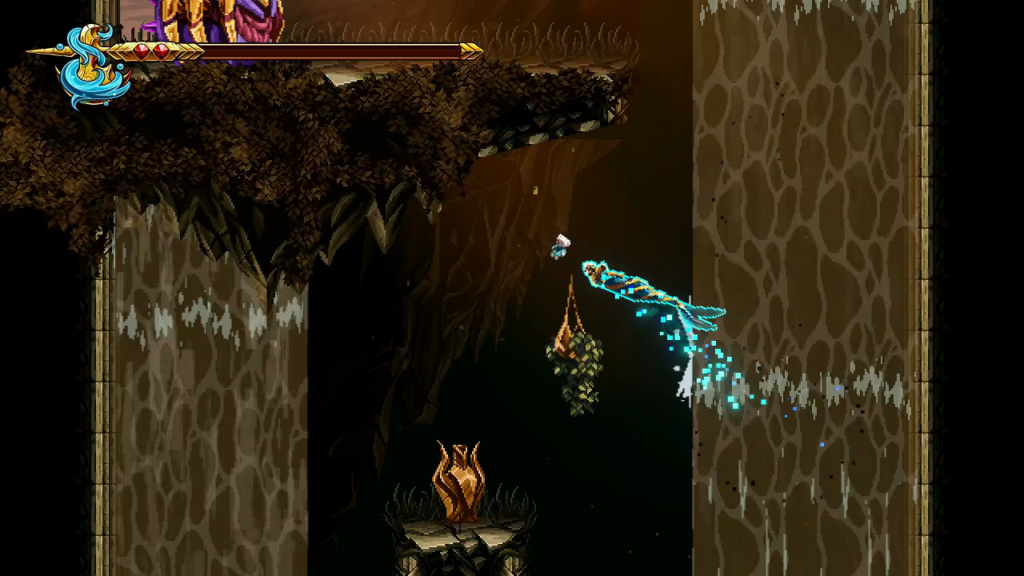
The armor Europa wears has immediate and noticeable effects. In exploration, the Poseidon Armor lets her transform into a mermaid to traverse water. The Gaia and Helios Armors provide her with immunity to poisonous and overheated environments along with more unusual transformation abilities. In combat, many monsters Europa encounters glow with colored auras. Matching the armor Europa wears with an enemy’s aura color causes her halberd to deal additional damage. There’s an effective unscripted tutorial against a particular enemy that teaches me to match its color weaknesses. While wearing the wrong armor, it’s a deadly foe, practically an unlabeled boss battle immune to most of Europa’s attacks. Switching to its weakness lets her cut it down in seconds.
As much as I like this armor-changing mechanic, it feels overutilized for exploration and underutilized for combat. When entering a room filled with water, poison, or fire, Europa switches to the appropriate suit of armor automatically and refuses to change no matter how many times I hammer the shoulder buttons. This is helpful for preventing unwanted environmental damage, but these rooms account for so much of Talos’ space that it often feels like I have little choice what armor Europa wears. Encountering an enemy glowing with a yellow aura in a room where I am not allowed to change Europa’s armor to the Grace of Zeus feels like being taunted. Most bosses also fail to utilize this mechanic. It’s a good idea that could be better if I could exploit it with more consistency against Talos’ threats.
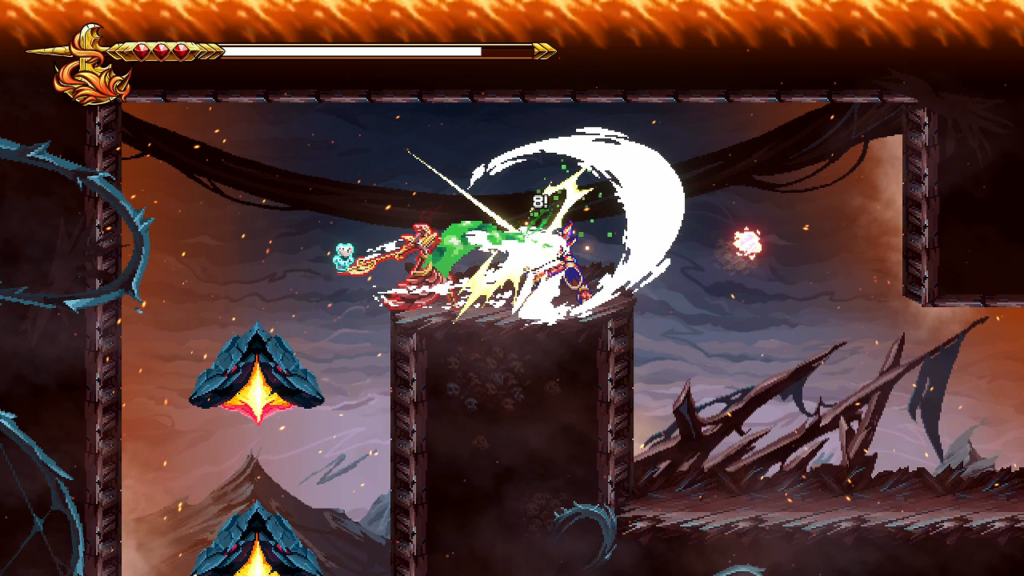
9 Years of Shadows’ most interesting spin on non-linear platforming combat is how Europa’s life meter works. Instead of a literal representation of her vitality, the light blue meter at the top of the screen represents a shield of light that Apino projects around Europa. The meter drains with every hit she takes in combat. When it empties, the next hit will remove one of the red gems embedded beside the meter. When Europa runs out of red gems, she dies and I must pick up her adventure from the last save point.
What makes this meter interesting is it is replenished as easily as it is drained. Apino’s shield is weak, breaking in only a few hits from most enemies. Larger enemies are capable of shattering it in a single hit. But the meter is just as easily restored, with a small fraction regenerating every time Europa strikes an enemy with her halberd. This encourages aggressive play; the best way to keep the shield topped out is to attack often.
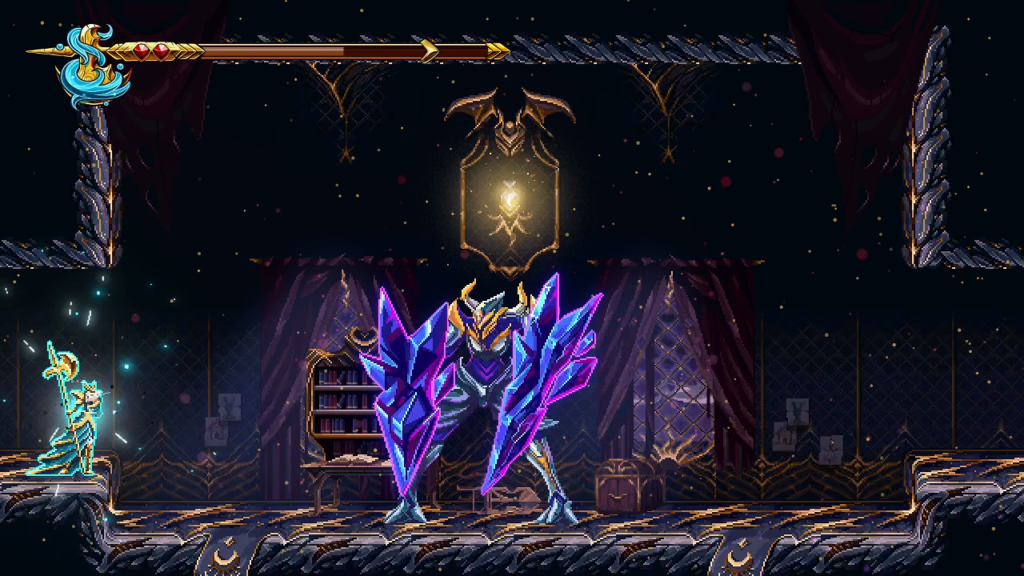
When the shield is completely emptied, it can be refilled by finding a safe spot where Europa can hug Apino for a few seconds. Against most basic enemies it’s easy enough to scramble away to a safe platform for a quick hug. Bosses are trickier prospects as there is often nowhere safe to stand and few lulls in their attack patterns. The closer Europa comes to lifting the curse, the more her battles with Talos’ bosses demand flawless performances.
The result of these life systems is that Europa feels physically fragile and magically durable simultaneously. Protracted battles go through exciting swings where Europa is a second away from death then suddenly returns to full power. Few other non-linear platforming protagonists feel the way she does in battle.
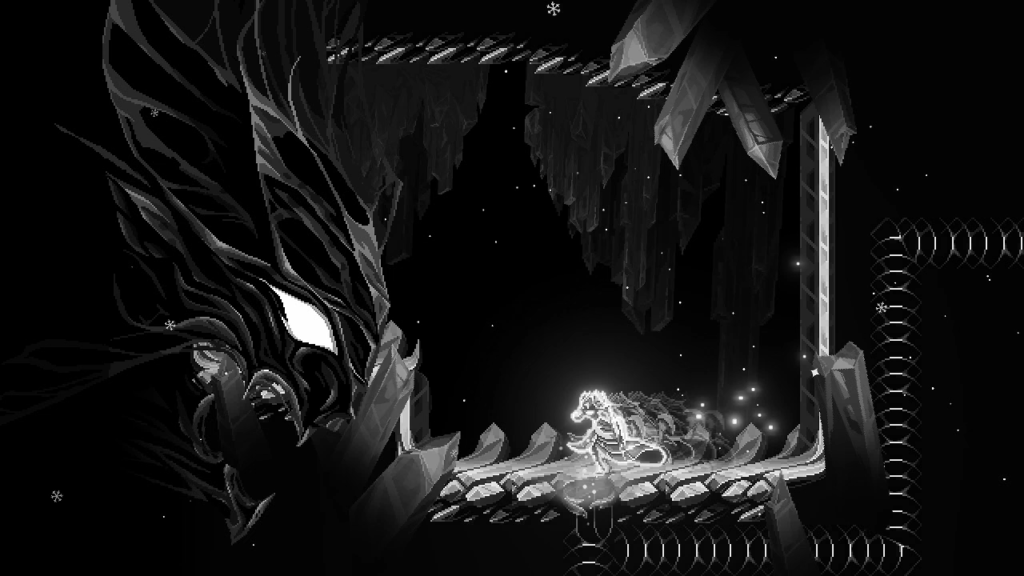
9 Years of Shadows is visually and thematically striking when I first approach it. I glean some understanding of the title when Europa first enters Talos and I see the entire castle rendered in greyscale. She must explore for several minutes and have a bad encounter with Belial, a demon that stalks Talos’ hallways, before she discovers Apino and his aura restores color to the world around her.
This is the point where 9 Years of Shadows’ thematic messaging becomes confused. Europa’s quest is to end the curse, which is visually represented by a lack of color. Mere minutes after entering Talos, color is restored. Though the curse lingers, its visual presence is immediately painted over.
Part of me struggles to criticize this too much because use of color is one of 9 Years of Shadows’ strongest aspects. Every region regales itself in a vivid and unique core color. Enemies are arrayed in bright coats that make them pop out against the environment. Europa’s different suits of armor have unique designs and color schemes, never leaving me in a moment’s doubt which one she is wearing at any given moment. Keeping the world in greyscale or restoring color more gradually would impede these impressive graphical flourishes.
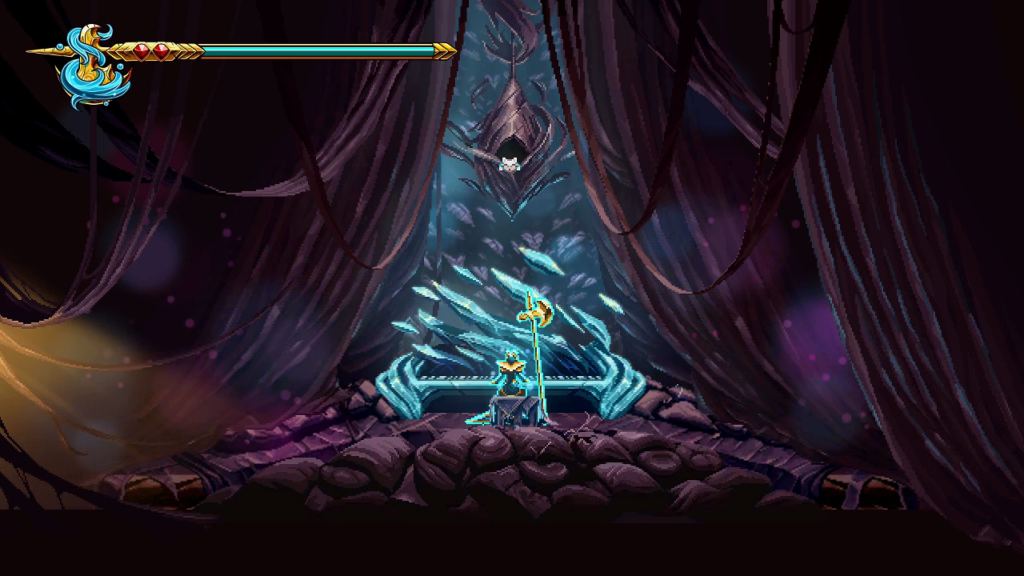
Despite these strengths, 9 Years of Shadows’ best visual ideas are in opposition to its most interesting narrative ones. Much of the time Europa spends in Talos is concerned with music. This further muddies and confuses its themes. Save points are marked by pianos, with Europa performing a sad tune on them each time the game is saved. A band of musicians is lost in Talos’ hallways; reuniting them in the many concert halls and defeating the optional bosses who distract them from playing well is the main sidequest that weaves throughout the entire adventure. Even the collectibles are focused on music. Europa can discover colored books of music and trade them to the musicians for upgrades to Apino’s light shield.
There’s nothing wrong with these colorful and musical ideas on their own, but when I look at 9 Years of Shadow as a whole, I ask myself how they fit together and conclude they do not. Europa enters Talos hoping to restore color to the world, and is immediately distracted restoring music to Talos. The idea of color returns in a big way by the climax, but by then Europa has spent so much time collecting music and helping musicians that I’ve almost forgotten the grey world away from Apino’s influence was ever a problem.
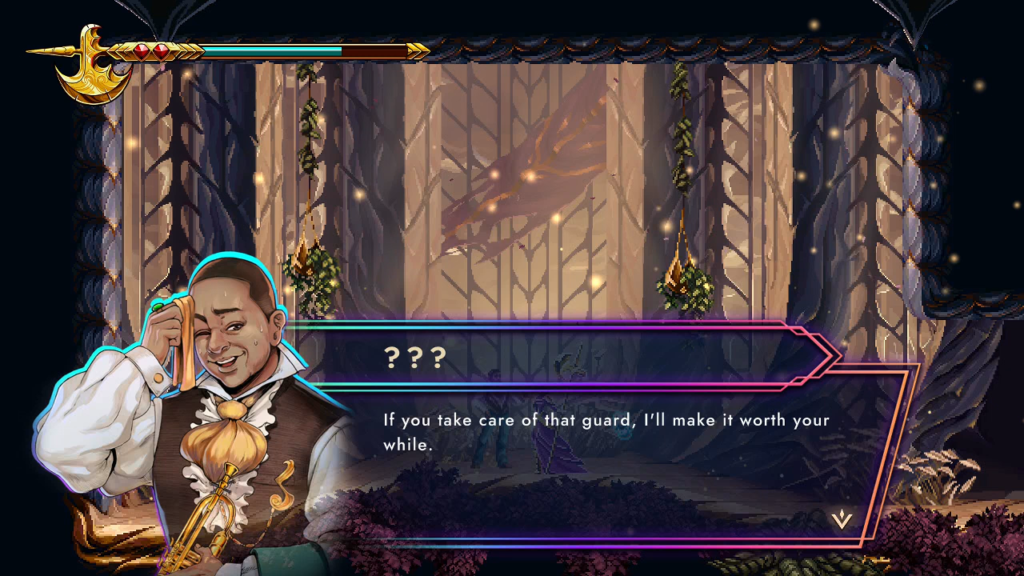
I chose to play 9 Years of Shadows through its recent Nintendo Switch port, and I wish I hadn’t. At first my experience is a positive one. The port runs well in early areas and Europa’s movements feel quick and responsive. The deeper into Talos she ventures, the more elaborate special effects she encounters, many of which cause the framerate to drop for an impactful moment. I persevere as these drops are only affecting what my eyes see and not my ability to succeed against Talos’ challenges. That changes when Europa reaches an optional boss at the end of the musicians’ quest chain; it utilizes so many effects that vex the port performance I find it impossible to overcome. Giving up that challenge, I proceed to the final boss, which thankfully is a playable, though still not flawless experience.
I have done some reading about performance of the PC version and found it has similar problems with many hardware configurations. My hope is that the Switch port will be patched soon to make its later events more stable. I have many criticisms for 9 Years of Shadow, but its port performance is the only reason I have to outright discourage anyone who may be interested in playing it on Switch.
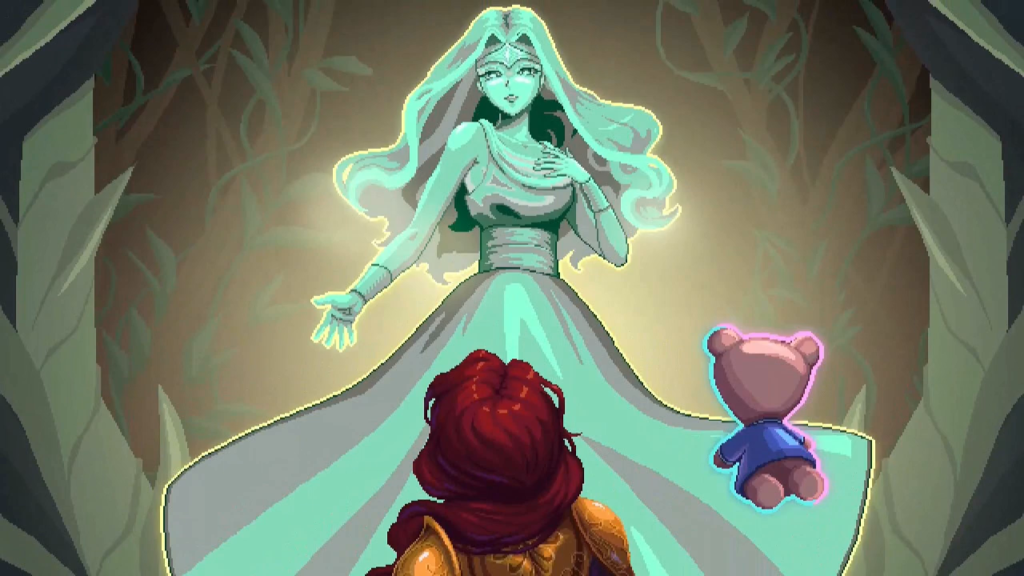
9 Years of Shadow feels like an unfinished puzzle whose pieces don’t fit together. Its individual components are passable to good on their own, but when assembled they create a jagged and confused picture with many obvious holes. Its combat contains its best ideas. Switching between Europa’s equipped armor in real time gives a dynamic and urgent feeling to battles—if she is allowed to change armor in the current room. The light shield creates a sense of tension that a traditional health meter lacks. Powerful enemies can drain it in a moment, but it can be restored just as quickly, making battles feel fierce and deadly. The levels where these battles take place aren’t interesting on a micro or a macro level; the individual areas Europa explores are unmemorable and are collectively spread out in a boring and predictable fashion. The theming gives me the most trouble, introducing then retracting intriguing ideas about color, then getting distracted by irrelevant musical tangents before suddenly remembering what this curse is really doing to the world. There’s a decent non-linear platformer here, but not a great one.